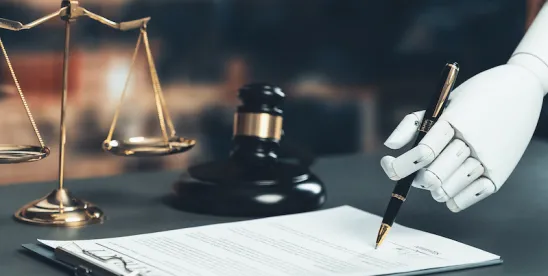Can generative AI function not merely as a tool but as a genuine teammate? This question was answered in a recently published Harvard Business School working paper1, led by researchers from HBS, Procter & Gamble, and The Wharton School, including Professor Ethan Mollick, among others.
The key results were striking. In a large-scale experiment with 776 professionals at Procter & Gamble (P&G), AI-assisted individuals performed at a level comparable to two-person teams without AI. Moreover, AI seemed to “bridge silos,” helping participants produce solutions outside their usual domain of expertise, and it also had a surprisingly positive impact on users’ emotional experience. These findings suggest that generative AI may transform how professionals collaborate, share expertise, and innovate.
In this article, I distill the core insights from the study, then explore how these lessons might be generalized for the legal sector. Finally, I propose an actionable roadmap for law firm partners. At a time when legal services are becoming ever more specialized, these findings offer a glimpse into how AI can help lawyers accelerate research, navigate complexity, and even increase overall job satisfaction.
- Key Lessons from the Study
AI as a Substitute for Team Collaboration. Traditionally, P&G employees work in small cross-functional teams (e.g., pairing R&D with Commercial) to develop new product ideas. This environment mirrors law firms’ multi-practice teams, which often bring together litigators, transactional attorneys, compliance specialists, and more. In the experiment, individuals with AI support produced outputs whose quality matched that of two-person teams without AI. Put plainly, AI replaced part of the collaborative “benefit” that usually arises when more than one human is involved. Although human teamwork still has intrinsic value, the study showed that GenAI could function much like a teammate, an ever-present collaborator available on demand.
AI as a Knowledge and Expertise “Equalizer.” The paper also found that AI helped non-specialists produce specialized solutions. For instance, professionals lacking R&D experience still performed at high levels when aided by GenAI. Equally striking, the AI encouraged more balanced thinking: R&D employees generated commercial-focused proposals just as frequently as Commercial employees did, and vice versa. AI effectively bridged domain gaps. For law firms, a similar dynamic may be at play. Young associates, or attorneys venturing beyond their typical focus areas, may leverage GenAI to expand their range: drafting, refining, or ideating on topics outside their usual “comfort zone.”
Emotional and Motivational Boost. Contrary to common fears that technology can depersonalize work, participants using AI reported significantly higher positive emotions (e.g., enthusiasm, energy) and fewer negative emotions (e.g., frustration). The interactive nature of large language models (LLMs) may explain why. Simply put, workers felt more supported and less isolated. For the legal profession, where high stress and burnout are all too familiar, this aspect may hold particular promise. If AI can absorb some of the more routine or painstaking aspects of legal work, attorneys may feel more energized to handle the complex, human-centric tasks that truly require their expertise.
- Why This Matters for Law Firms
Law firms today confront a complex blend of client demands, rapid regulatory changes, and cost pressures. Major client matters often require specialized skill sets across multiple legal domains: mergers and acquisitions, IP, antitrust, data privacy, environmental law, and so forth. Teams spend countless hours coordinating each piece of the puzzle. Moreover, the business side of law, marketing, client development, and knowledge management, often runs in parallel silos. In many firms, partners and practice leaders lament that cross-practice synergy does not happen as seamlessly as they would like.
The P&G study signals that GenAI can potentially step in as a “universal collaborator.” Instead of simply churning out boilerplate text, AI can:
- Offer real-time expertise: Summarize new legislation, check case law, or offer multiple lines of argument as an “always-on collaborator.”
- Enhance cross-practice synergy: Encourage a more balanced approach by exposing attorneys to perspectives outside their usual specialty.
- Streamline work, reduce stress: Save hours of routine drafting or research and “hand off” partial tasks to the AI, freeing attorneys to focus on higher-level strategy or client engagement.
- From Theory to Action: A Playbook for Law Firm Partners
Great insights, but how to put them into practice? Below is a suggested roadmap, based on the study’s findings, for law firms looking to integrate AI into their practice in a way that enhances teamwork, expertise, and job satisfaction.
Start Small: Pilot AI in a Targeted Practice Group. Begin by running a carefully designed pilot in a discrete practice area, say, corporate or litigation support, where tasks are high-volume and somewhat repeatable (e.g., drafting standard agreements, initial research, or summarizing depositions).
- Assign an AI “Champion”: Choose a partner (or senior associate) who believes in the potential of AI and can serve as the go-to resource.
- Define “Success” Metrics: For instance, measure (1) average time saved, (2) quality of deliverables, and (3) user satisfaction.
Redesign Workflows to Treat AI as a Team Member
If the P&G experiment is any indication, GenAI can step into roles traditionally filled by junior attorneys or paralegals. That doesn’t mean replacing people; rather, it means reshaping how tasks are allocated or how their job duties are defined.
- Task Decomposition: Break down legal work into smaller chunks. Let AI handle discrete elements (e.g., searching for relevant cases, generating multiple versions of a clause).
- Iteration & Review: Humans add the final legal judgment and personal expertise. As the study showed, the best outputs came from iterative, back-and-forth engagement with AI.
Invest in Prompt Crafting and AI Training
Those who benefited the most from AI in the P&G study were those who engaged iteratively. “Ask AI a question, incorporate its feedback, refine the prompt, and ask again.” This is a skill that can be honed.
- Workshops and Templates: Provide attorneys with example prompts for different tasks: brief writing, interrogatories, contract drafting, client memos.
- Build Confidence & Caution: Encourage lawyers to double-check references, confirm sources, and use AI outputs as a springboard rather than a final answer.
Foster an “AI + Human” Culture to Bridge Silos
The study’s participants found that AI broadened their horizons, making them more comfortable addressing topics beyond their functional expertise. Law firms can build on this by designing cross-practice “collaboration labs.”
- Virtual Collaboration Sprints: Pair attorneys from different specialties, equip them with AI, and let them co-develop novel solutions, for instance, a “privacy + employment” approach to compliance.
- Sharing Success Stories: Publicize how AI helped cross-practice collaboration, for example, a corporate lawyer who used AI to weigh in on IP issues or a litigator who used AI to refine transactional language. This normalizes cross-practice learning.
Monitor Emotional Engagement
One of the study’s most surprising findings is that AI can actually increase enthusiasm and decrease frustration. Law firm leadership might consider adding a short “emotional check-in” to pilot programs or post-project reviews.
- Simple Pulse Surveys: Ask attorneys whether AI tools eased or exacerbated stress.
- Emphasize Mentoring: If junior lawyers feel more energized using AI, ensure the firm invests that extra energy into training, professional development, and mentorship, rather than merely piling on more work.
Plan for Ethical and Risk Mitigation
Finally, as attorneys well know, legal practice demands rigorous adherence to client confidentiality, privilege, and ethical guidelines. Incorporate the following safeguards:
- Confidentiality Protocols: Ensure AI platforms are approved, secure, and configured to avoid inadvertent disclosure of client data.
- Transparent Boundaries: Partners should clarify how AI was used in drafting or research, especially for documents shared externally.
- Ongoing Supervision: Even the best AI can produce flawed or “hallucinated” references. A structured quality-control protocol is essential for accuracy and ethical compliance.
Closing Thoughts
The Cybernetic Teammate study offers an eye-opening glimpse of how AI might reshape legal work. While lawyers have long relied on collaboration (juniors, seniors, experts, paralegals, librarians, and more) this new research suggests that generative AI can serve as a flexible, on-demand collaborator.
Far from merely automating tasks, AI’s language-based interface can stimulate creativity, bridge silos, and encourage greater engagement. In a legal world where time and expertise are invaluable, the potential to standardize routine tasks, extend specialized knowledge, and reduce stress is profound.
Yet, the lawyers and the firms that stand to gain the most from generative AI will be those that treat it as a genuine teammate. That means investing in prompt-crafting skills, rethinking staffing structures, systematically incorporating AI into everyday workflows, and ensuring ethical guardrails. By combining the best of human judgment with the scale and speed of AI, law firms can position themselves at the vanguard of modern legal practice.
In short, the arrival of the “cybernetic teammate” points not just to incremental improvement but to a chance for genuine transformation. As the study shows, AI may not only amplify the business side of law firms but also improve the experience of practicing attorneys. Done right, it can help create a culture of continuous learning, broader expertise, and higher-impact client service, creating a win-win-win: benefiting partners, associates, and clients alike.
1Dell'Acqua, Fabrizio, Charles Ayoubi, Hila Lifshitz, Raffaella Sadun, Ethan Mollick, Lilach Mollick, Yi Han, Jeff Goldman, Hari Nair, Stew Taub, and Karim R. Lakhani. "The Cybernetic Teammate: A Field Experiment on Generative AI Reshaping Teamwork and Expertise." Harvard Business School Working Paper, No. 25-043, March 2025.




 />i
/>i

